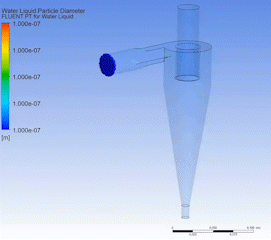New Device Can Detect Covid in the Air Within Five Minutes
Researchers report the technology is 77 to 83 percent accurate in finding any of the coronavirus variants in a room
:focal(380x271:381x272)/https://tf-cmsv2-smithsonianmag-media.s3.amazonaws.com/filer_public/8c/dc/8cdc0ce6-78da-48bb-a667-60aa74fffb01/img_0827_team_h.jpg)
Researchers have created a new rapid SARS-CoV-2 detection device that can pick up and identify viral particles from the air within five minutes. The proof-of-concept detector could eventually be used to scan for the virus in hospitals, shopping centers, airports and other public places—and it could even help policymakers with management strategies, the team says.
“There is nothing at the moment that tells us how safe a room is,” John Cirrito, a neurologist at Washington University in St. Louis (WUSTL) says in a statement. “If you are in a room with 100 people, you don’t want to find out five days later whether you could be sick or not. The idea with this device is that you can know essentially in real time, or every five minutes, if there is a live virus in the air.”
Until now, devices meant to detect airborne viruses in real time struggled to suck up enough air to concentrate virus particles, reports Tina Hesman Saey for Science News. Previous attempts at the technology have only managed to take in two to eight liters of air per minute, per the publication. They also couldn’t test the air immediately—these techniques relied on additional PCR testing of the samples, which can take as long as 24 hours to give results, writes Alice Park for Time magazine.
But Cirrito and a team at WUSTL have engineered a device that can suck in air at about 1,000 liters per minute, circulating it like a cyclone. As it twirls, the detector traps viral particles in a liquid solution within. After about five minutes, a biosensor—made of an electrode attached to an immune system protein from a llama—reads the solution. These llama proteins, called nanobodies, stick to the spike proteins of any passing coronavirus that might be present.

Next, an electrical current passes through the sensor, which leads the virus’s spike protein to lose electrons. When another sensor detects that change, the device verifies the presence of Covid. The design was based on a previous version used to detect a protein found in the brains of Alzheimer’s patients.
In a study published last week in Nature Communications, the scientists report the device is 77 to 83 percent accurate in detecting any of the coronavirus variants in the air, though it cannot distinguish between them. The team also tested the monitor in the apartments of two Covid-positive patients. The devices detected the virus after just five minutes.
“They’ve demonstrated that it works. It’s able to detect [the] virus at low levels that we would be concerned about in the air,” Linsey Marr, an aerosol scientist at Virginia Tech who studies the spread of viruses and was not involved in the study, tells Science News.
The device costs about $1,400 to $1,900 to build in a lab, per Science News. Eventually, the team says the microwave-sized detector could be engineered to scan for other airborne viruses too.
“We’re thinking, what are the pathogens that make people sick? Most times, it’s influenza, RSV, which are probably at the top of our list,” Cirrito tells Sarah Fentem of St. Louis Public Radio. “As long as there’s a protein on the surface, we have the opportunity to potentially be able to detect it with this kind of technology.”
/https://tf-cmsv2-smithsonianmag-media.s3.amazonaws.com/accounts/headshot/MargaretOsborne.png)
/https://tf-cmsv2-smithsonianmag-media.s3.amazonaws.com/accounts/headshot/MargaretOsborne.png)